Raymond Loewy
Raymond Loewy (/ˈloʊi/ LOH-ee, French: [ʁɛmɔ̃ levi];[2] November 5, 1893 – July 14, 1986) was a French-born American industrial designer who achieved fame for the magnitude of his design efforts across a variety of industries. He was recognized for this by Time magazine and featured on its cover on October 31, 1949.[3]
Raymond Loewy | |
|---|---|
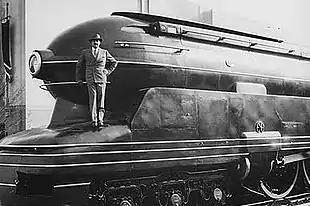 Loewy standing on one of his designs, the Pennsylvania Railroad's S1 steam locomotive | |
| Born | November 5, 1893 |
| Died | July 14, 1986 (aged 92) |
| Resting place | Rochefort-en-Yvelines Cemetery, Rambouillet, France |
| Citizenship | France, United States |
| Education | University of Paris |
| Occupation | Industrial Designer |
| Years active | 1909–1980 |
Notable work |
|
| Spouse(s) | Jean Thompson Bienfait[1] (m. 1931–1945; divorced) Viola Erickson (m. 1948–1986; his death) |
| Children | 1 |
| Website | Raymondloewy.com |
He spent most of his professional career in the United States, becoming a naturalized citizen in 1938. Among his designs were the Shell, Exxon, TWA and the former BP logos, the Greyhound Scenicruiser bus, Coca-Cola vending machines and bottle redesign,[4] the Lucky Strike package, Coldspot refrigerators, the Studebaker Avanti and Champion, and the Air Force One livery. He was engaged by equipment manufacturer International Harvester[5] to overhaul its entire product line, and his team also assisted competitor Allis-Chalmers.[6] He undertook numerous railroad designs, including the Pennsylvania Railroad GG1, S-1, and T1 locomotives, the color scheme and Eagle motif for the first streamliners of the Missouri Pacific Railroad, and a number of lesser known color scheme and car interior designs for other railroads. His career spanned seven decades.
The press referred to Loewy as The Man Who Shaped America, The Father of Streamlining and The Father of Industrial Design.[7]
Early life
Loewy was born in Paris in 1893, the son of Maximilian Loewy, a Jewish journalist from Austria, and a French mother, Marie Labalme. Loewy distinguished himself early with the design of a successful model aircraft, which won the Gordon Bennett Cup for model airplanes in 1908.[8] By the following year, he had commercial sales of the plane, named the Ayrel.
Loewy served in the French army during World War I (1914–1918), attaining the rank of captain. He was wounded in combat and received the Croix de guerre. After the war he moved to New York, where he arrived in September 1919.
Career
Early work
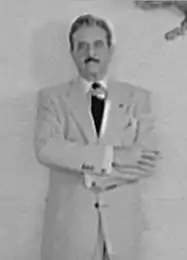
In Loewy's early years in the United States, he lived in New York and found work as a window designer for department stores, including Macy's, Wanamaker's and Saks in addition to working as a fashion illustrator for Vogue and Harper's Bazaar. In 1929 he received his first industrial-design commission to contemporize the appearance of a duplicating machine by Gestetner. Further commissions followed, including work for Westinghouse, the Hupp Motor Company (the Hupmobile styling), and styling the Coldspot refrigerator[9] for Sears-Roebuck. It was this product that established his reputation as an industrial designer. He opened a London office in the mid-1930s that continues to operate.[10]
Pennsylvania Railroad
In 1937, Loewy established a relationship with the Pennsylvania Railroad, and his most notable designs for the firm involved some of their passenger locomotives. He designed a streamlined shroud for K4s Pacific #3768 to haul the newly redesigned 1938 Broadway Limited. He followed by styling the experimental S1 locomotive, as well as the T1 class. In 1940, he designed a simplified version of the streamlined shroud for another four K4s. In 1942, he designed the streamlined shroud for the experimental duplex engine Q1 which was his last work of streamlining PRR's steam engine.
In 1946, at the Pennsylvania Railroad's request, he restyled Baldwin's diesels with a distinctive "sharknose" reminiscent of the T1. He also designed the experimental steam turbine engine V1 "Triplex" for PRR which was never built. While he did not design the famous GG1 electric locomotive, he improved its appearance with welded rather than riveted construction, and he added a pinstripe paint scheme to highlight its smooth contours.
In addition to locomotive design, Loewy's studios provided many designs for the Pennsylvania Railroad, including stations, passenger-car interiors, and advertising materials. By 1949, Loewy employed 143 designers, architects, and draftsmen. His business partners were A. Baker Barnhart, William Snaith, and John Breen.[11]
Studebaker


Loewy had a long and fruitful relationship with American car maker Studebaker. Studebaker first retained Loewy and Associates and Helen Dryden as design consultants in 1936[12]:[p.247] and in 1939 Loewy began work with the principal designer Virgil Exner.[12][13] Their designs first began appearing with the late-1930s Studebakers. Loewy also designed a new logo to replace the "turning wheel" that had been the Studebaker trademark since 1912.[12]
During World War II, American government restrictions on in-house design departments at Ford, General Motors, and Chrysler prevented official work on civilian automobiles. Because Loewy's firm was independent of the fourth-largest automobile producer in America, no such restrictions applied. This permitted Studebaker to launch the first all-new postwar automobile in 1947, two years ahead of the "Big Three." His team developed an advanced design featuring flush-front fenders and clean rearward lines. The Loewy staff, headed by Exner, also created the Starlight body, which featured a rear-window system that wrapped 180° around the rear seat.
In addition to the iconic bullet-nosed Studebakers of 1950 and 1951, the team created the 1953 Studebaker line, highlighted by the Starliner and Starlight coupes. (Publicly credited to Loewy, they were actually the work of Robert Bourke.[14])
The Starlight has consistently ranked as one of the best-designed cars of the 1950s in lists compiled since by Collectible Automobile, Car and Driver, and Motor Trend. The '53 Starliner, recognized today as "one of the most beautiful cars ever made",[15] was radical in appearance, as radical in its way as the 1934 Airflow. However, it was beset by production problems.[15]
To brand the new line, Loewy also contemporized Studebaker's logo again by applying the "Lazy S" element. His final commission of the 1950s for Studebaker was the transformation of the Starlight and Starliner coupes into the Hawk series for the 1956 model year. The photo to the right actually shows a Starliner hardtop, which does not have the "C" pillar.
In the spring of 1961, Studebaker's new president, Sherwood Egbert, recalled Loewy to design the Avanti. Egbert hired him to help energize Studebaker's soon-to-be-released line of 1963 passenger cars to attract younger buyers.
Despite the short 40-day schedule allowed to produce a finished design and scale model, Loewy agreed to take the job. He recruited a team consisting of experienced designers, including former Loewy employees John Ebstein; Bob Andrews; and Tom Kellogg, a young student from the Art Center College of Design in Pasadena. The team worked in a house leased for the purpose in Palm Springs, California. (Loewy also had a home in Palm Springs that he designed himself.[16]) Each team member had a role. Andrews and Kellogg handled sketching, Ebstein oversaw the project, and Loewy was the creative director and offered advice.

NASA
Raymond Loewy worked for NASA from 1967 to 1973[17] as a Habitability Consultant for design of the Skylab space station, launched in 1973.[18] One of NASA's goals in hiring him was to improve the psychology, safety, and comfort of manned spacecraft.[17] Due to long duration confinement in limited interior space in micro-g with almost non-existing variability in environment, the comfort and well-being of the crew through the use of esthetics played high importance. Loewy suggested a number of improvements to the layout, such as the implementation of a wardroom, where the crew could eat and work together, the wardroom window, the dining table and the color design, among others. A key feature of Raymond Loewy's design for the sleep compartments was that the floor plan for each of the three was different to create a sense of individual identity for each compartment. Elements of the crew quarters included sleep restraints, storage lockers, privacy partitions, lighting, a light baffle, privacy curtains, mirrors, towel holders and a communication box.[19] The table was designed by Loewy in order to avoid creating hierarchical positions for crew members during long missions. Food was eaten using forks, knives and spoons, which were held in place on the table by magnets. Liquids were drunk from squeezable plastic containers.[19][20]
International Harvester
The International Harvester company was a manufacturer of agricultural machinery and construction equipment. In 1935 it engaged Loewy to overhaul the product line, from the company's logo to operator ergonomics. The first new machine to reflect Loewy's design aesthetic, a crawler tractor known as the International TD-18,[21] was launched in 1938.[5]
Allis-Chalmers
Raymond Loewy's designers influenced the design of Allis-Chalmers crawler tractors.[6] The tractors were described as having stylish panelwork with curvaceous lines.[6]
Personal life, death and legacy
In 1980, Loewy retired at the age of 87 and returned to his native France.
He died in his Monte Carlo residence in 1986. He was raised a Roman Catholic and was buried in the cemetery of a Catholic church[22] in Rochefort-en-Yvelines,[23] a village located 40 km south-west of Paris, where he owned the castle de la Cense. He was survived by his wife Viola, and their daughter Laurence.
Foundation
In 1992, Viola and Laurence Loewy, with the support of British American Tobacco, established the Raymond Loewy Foundation in Hamburg, Germany. The foundation was established to preserve the memory of Raymond Loewy and promote the discipline of industrial design. An annual award of €50,000 is granted to outstanding designers, in recognition of their lifetime achievements. Notable grantees include Karl Lagerfeld, Philippe Starck and Dieter Rams.
Design philosophy
In 1998, Loewy's daughter, Laurence, established Loewy Design in Atlanta, Georgia, to manage her father's continued interests in the United States. In 2006, the Loewy Gallery,[24] opened in Roanoke, Virginia, through the supportive efforts of the O. Winston Link Museum, the local business community, art patrons, Laurence Loewy, David Hagerman, and Ross Stansfield. Laurence died of natural causes October 15, 2008, and is survived by her husband David Hagerman. Hagerman is the representative for the Estate of Raymond Loewy, which remains dedicated to reintroducing Loewy's design philosophy of MAYA, or "most advanced, yet acceptable",[25] to a new generation, through design exhibitions, publications, and documentaries. In October 2017, the documentary, Raymond Loewy: designer of American dreams, originally conceived by Laurence Loewy, premiered to Paris audiences. The film has aired on the French Arte channel.[26]
Google doodle
On November 5, 2013, Loewy was honored with a Google Doodle depicting a streamlined locomotive bearing a resemblance to the K4s Pacific#3768 shroud design, using the wheels of the train to form the word Google.[27]
Loewy designs
|
1900s
1920s
1930s
1940s
|
1950s
1960s
1970s
Work in years or models unknown
|
Gallery
 A 1946 Lincoln Continental
A 1946 Lincoln Continental 1953 Studebaker Commander Starliner hardtop
1953 Studebaker Commander Starliner hardtop A concept sketch of the 1963 Avanti by Loewy
A concept sketch of the 1963 Avanti by Loewy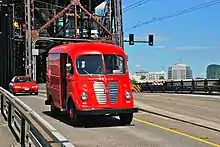 A preserved Metro Van in 2012
A preserved Metro Van in 2012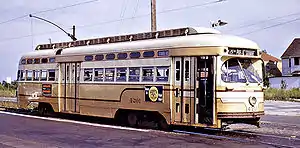 A PCC (Presidents' Conference Committee} streetcar in Cleveland in 1950
A PCC (Presidents' Conference Committee} streetcar in Cleveland in 1950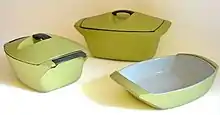 Le Creuset dishes
Le Creuset dishes 1937 Thermos flask
1937 Thermos flask 1948 Midel T-54 television set
1948 Midel T-54 television set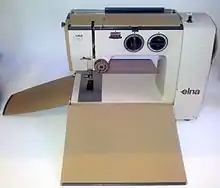 Elna Lotus portable folding sewing machine
Elna Lotus portable folding sewing machine.jpg.webp) Anscoflex II
Anscoflex II A Leisurama house in Montauk, New York; Leisurama houses could be purchased at Macy's department store
A Leisurama house in Montauk, New York; Leisurama houses could be purchased at Macy's department store Union News coffee shop at the TWA Flight Center, Idlewild] Airport (JFK)
Union News coffee shop at the TWA Flight Center, Idlewild] Airport (JFK)_crop.jpg.webp) Air Force One with Loewy-designed livery
Air Force One with Loewy-designed livery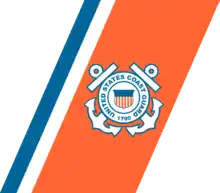 The USCG Racing Stripe logo (1964)
The USCG Racing Stripe logo (1964) The Exxon logo, designed in 1966, introduced in 1972
The Exxon logo, designed in 1966, introduced in 1972
Published books
See also
- Norman Bel Geddes
- Streamline Moderne, design era
- Lester C. Tichy, Loewy's protégé and another Pennsylvania Railroad designer.
References
Notes
- Hagley Digital Images Archived 2013-11-05 at Archive.today
- Duden – Das Aussprachewörterbuch (in German) (8 ed.). Berlin: Dudenverlag. 2015. ISBN 978-3-411-05508-1.
- Loewy on the cover of Time (October 31, 1949)
- "The History Behind the Coca-Cola Bottle". The Coca-Cola Company. Retrieved October 20, 2019.
When King and Family sized packaging were introduced in 1955, Raymond Loewy was part of the team that worked to recast the bottle but still keep the proper proportions.
- The Big Book of Farmall Tractors. ISBN 978-1610605168.
- https://contractormag.co.nz/classic-machines/allis-chalmers-hd-14/
- "FastFacts" on Raymondloewy.com
- Loewy, Raymond (2002). Never Leave Well Enough Alone. Johns Hopkins University Press. p. 28. ISBN 978-0-8018-7211-2.
- Coldspot Refrigerator
- Loewy Group marketing agency Archived 2007-11-24 at the Wayback Machine
- Staff (October 31, 1949) "Up from the Egg", Time
- Hendry, Maurice M. Studebaker: One can do a lot of remembering in South Bend. New Albany: Automobile Quarterly. pp. 228–275. Vol X, 3rd Q, 1972.
- Setright, L.J.K., "Loewy: When styling became industrial design", in Northey, Tom, ed. World of Automobiles (London: Orbis, 1974), Volume 11, p. 1211.
- Automotive Design Oral History – "Reminiscences of Robert E. Bourke"
- Ludvigsen, p. 2227
- Bloch, John, director and producer: Agronsky, Martin, host, (February 23, 1958). "Look Here. Raymond Loewy". NBC Television Presents, LCCN 96-507681
- Novak, Matt (October 13, 2014) "Raymond Loewy's NASA Designs Are The Space Future That Never Was" Paleofuture
- Torchinsky, Jason (May 13, 2014) "Why Skylab Was America's First And Best Home In Space" Jalopnik
- Hauplik-Meusburger, Sandra. (2011). Architecture for astronauts : an activity-based approach. Vienna: SpringerWienNewYork. ISBN 978-3709106679. OCLC 759926461.
- Loewy, Raymond, 1893–1986. (1988) [1979]. Industrial design. London: Fourth Estate. ISBN 0947795383. OCLC 18326758.CS1 maint: multiple names: authors list (link)
- https://contractormag.co.nz/classic-machines/td-18/
- L’église de Rochefort et son cimetière Archived 2013-12-03 at the Wayback Machine on the official website of Rochefort-en-Yvelines.
- "Raymond Loewy (1893–1986)" (in French). Mairie of Rochefort-en-Yvelines. Archived from the original on December 22, 2015.
- https://www.1717design.com
- Thompson, Derek. "The Four-Letter Code to Selling Just About Anything". The Atlantic. Retrieved December 3, 2018.
- ARTE. "Raymond Loewy, le designer du rêve américain". ARTE Boutique – Films et séries en VOD, DVD, location VOD, documentaires, spectacles, Blu-ray, livres et BD (in French). Retrieved 2018-12-03.
- "Google Doodle celebrates the 'father of industrial design' Raymond Loewy". IGN. November 5, 2013. Retrieved November 4, 2013.
- "Hughes' Stratoliner". Planeboats.com. Retrieved October 25, 2009.
- "Hallicrafters SX-42 shortwave radio made 1946–1947". Arsmachina.com. Archived from the original on December 31, 2005. Retrieved November 5, 2013.
- "National Register Information System". National Register of Historic Places. National Park Service. July 9, 2010.
- Harnesberger, Douglas J. and Kraus, Nancy (July 1998). "National Register of Historic Places Inventory/Nomination: Norfolk and Western Railway Company Historic District" (PDF). Virginia Department of Historic Resources. Archived from the original (PDF) on September 27, 2012.CS1 maint: multiple names: authors list (link)
- Nichols, Chris (July 23, 2014). "A Look Back at Robinson's as the Glamorous Beverly Hills Store is Demolished". Los Angeles magazine.
- "Designed to Travel; Curating Relics of T.W.A. As It Prepares for Departure". The New York Times. June 7, 2001.
- Staff. "Union News restaurants, TWA, Idlewild. Lisbon Lounge". United States Library of Congress. Retrieved November 1, 2014.
- Valet 2000/50 Dressing Cabinet
- American Treasures of the Library of Congress, "Design drawing for Exxon logo by Raymond Loewy"
- "SPAR". Raymond Loewy Foundation. Retrieved October 25, 2009.
- Staff (July 2009). "Celebrate America this July with Gary Kollberg's Exhibit at the Farmington Library". Farmington, Connecticut: Farmington Library of Art.
- Wilson, Patrick (March 23, 2009). "What's in a name? Scope Arena, Norfolk". The Virginian Pilot.
Further reading
- Bayley, Stephen. The Lucky Strike Packet (Design Classics Series), Art Books International Ltd (1998) ISBN 3-931317-72-2
- Byars, Mel. "Loewy, Raymond" in American National Biography, American Council of Learned Societies (2000)
- Porter, Glenn. Raymond Loewy Designs for the Consumer Culture, Hagley Museum and Library (2002) ISBN 0-914650-34-3
- Schoenberger, Angela. Raymond Loewy: Pioneer of American Industrial Design, Prestel Publishing (1991) ISBN 3-7913-1449-1
- Trétiack, Phillippe. Raymond Loewy and Streamlined Design, New York: Universe (1999) ISBN 0-7893-0328-0
- Wall, John. Streamliner: Raymond Loewy and Image-making in the Age of American Industrial Design, Johns Hopkins University Press (2018) ISBN 978-1421425740
External links
| Wikiquote has quotations related to: Raymond Loewy |
| Wikimedia Commons has media related to Raymond Loewy. |
- RaymondLoewy.com – official site website of Raymond Loewy
- RaymondLoewy.org – official site of Estate of Raymond Loewy
- The Raymond Loewy Foundation
- Raymond Loewy Tribute Site (English/German)
- Raymond Loewy archive (1903–1982) at Hagley Museum and Library. This collection consists of Loewy's personal papers, business records, and materials generated and maintained by Loewy's New York Public Relations Department as well as some of Viola Loewy's personal papers.
- Raymond Loewy Collection of Photographs and Audiovisual Materials (1905–1980) at Hagley Museum and Library. This collection is composed of images of design work Loewy and his firm conducted for corporate American and foreign clients; Loewy's personal photographs; and his speeches and interviews.
- Raymond Loewy miscellany (1936–1995) at Hagley Museum and Library. The collection consists of magazine advertisements, photos and postcard views of Loewy designs, product brochures; and a group of publications by and about Loewy. There is also a small group of artifacts.
- Raymond Loewy at Find a Grave